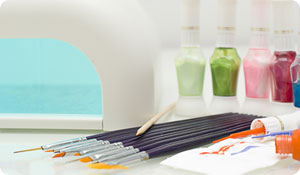
Gel manicures may be the hottest offer at your local nail salon. They're rumored to last for weeks and are relatively affordable. But before you turn your hands over to a nail tech, be sure to know what you're getting into and know the associated risks.
Different forms of gel manicures have been around for years as an alternative to acrylic nails. Recently, they've gained popularity among people who usually choose natural nail manicures, thanks to the fact that a gel manicure can last three or four times longer than a traditional one. During a gel manicure, your nails are trimmed and filed, and any tips desired are applied. The technician applies a gel solution over the nails, and then the nails are "baked" under a UV light to help harden and seal the gel.
Gel manicures carry some unique safety risks along with the same problems that traditional salon manicures can cause. Bacterial, fungal, or viral infections are easily transmitted from improperly cleaned tools or equipment. Regardless of what kind of manicure you're getting, it's always a good idea to bring your own tools. Additionally, the strength that makes gel manicures so desirable can cause additional issues.
First, regular UV exposure—just like the kind you get from sun-bathing or tanning beds—can lead to skin cancer. Gel manicures require exposing the sensitive skin around the nails to intense beams of UV light, and dermatologists have seen patients with squamous cell carcinomas on their fingers. This is a greater problem for routine users. Some salons do promote UV alternatives to dispel fears about these risks.
Gel manicures can also contain hidden acrylic substances that can cause allergic reactions or even fingernail deformity. These products are not monitored by the FDA and can contain potentially damaging ingredients. Be wary of deals that seem too good to be true. They may be using a cut-rate product containing hidden ingredients.
The final concern is the extensive amount of acetone required in order to fully remove the gel polish. Rubbing your nails with regular nail polish remover won't work—your fingers need to be fully submerged in acetone to break down this tough substance. If you get regular gel manicures, this could over-dry the nail, cause brittleness, and irritate the skin surrounding it. Some doctors have concerns about the acetone's safety. Many drugstore-brand nail polish removers are non-acetone for this very reason.
Chances are that getting the occasional gel manicure won't have negative effects on your health, particularly if you take precautions and use a trusted salon. However, you should weigh your options before making them a permanent part of your beauty routine.
Sources:
FDA.org: "How Nail Products Are Regulated." U.S. Food and Drug Administration. Web. March 9, 2010.
http://www.fda.gov/Cosmetics/ProductandIngredientSafety/ProductInformation/ucm127068.htm#reg
EWG.org: "Environmental Working Group & Skin Deep Cosmetic Safety Database." Web. 2011
http://www.ewg.org/skindeep/ingredient/700081/ACETONE/





